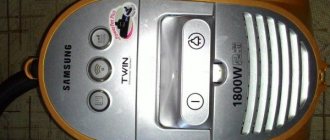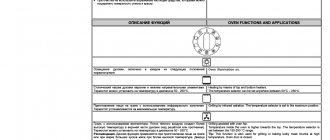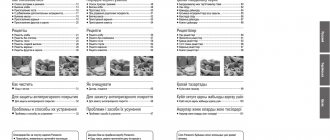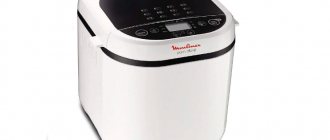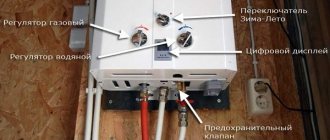Please read these instructions before contacting the service center.
Page 2
- Image
- Text
2
Read these instructions
This manual consists of sections “Safety Precautions”, “Operating Instructions”,
"Installation Guidelines" and "Troubleshooting" Carefully read this manual
before using the dishwasher will help you use and maintain the dishwasher
car properly.
Before contacting the service center
The "Troubleshooting" section will allow you to solve some problems when using
dishwasher without calling a service center specialist.
WITH A POLICY OF CONTINUOUS DEVELOPMENT AND UPDATE OF THE PRODUCT, THE MANUFACTURER MAY MAKE IMPROVEMENTS TO THE PRODUCT WITHOUT PRIOR NOTICE.
Advantages and disadvantages
The range includes dozens of models with standard and additional features. A large selection of products in different price segments simplifies the choice for the consumer. In addition to the distinctive features of dishwashers, there are several common pros and cons.
Pros:
- a large selection of programs - the buyer buys a machine with the necessary modes without overpaying for it;
- the equipment is thought out to the smallest detail - the chamber will fit large dishes and small items;
- the machine is equipped with three unusually shaped sprinklers located in different corners for better cleaning;
- the leak protection system allows you to avoid a flood if the hose is damaged;
- The dishes are always clean and dry.
Minuses:
- some models are noisy;
- fasteners, valves and filters are made of plastic;
- Not all machines have the ability to partially load.
About
B. loading salt, C. filling the rinse aid dispenser
Page 7
- Image
- Text
7
B. LOADING SALT
Use only salt designed for dishwashers. Use any
other salt, especially table salt, may damage the machine. The manufacturer does not provide
no warranty for the device in the event of its breakdown as a result of using salt that was not intended for
for dishwashers.
Fill the container with salt before selecting one of the full cycle wash programs. This will prevent
the possibility of corrosion formation as a result of being woken up and left for a while
time there are salt particles or salt water in the container.
The salt container is located under the lower grid and must be filled in the following order:
1.
Remove the lower basket, then unscrew and remove the lid of the salt container.
2.
If you are filling the container for the first time, fill it with water to 2/3 of its volume.
(approximately 500 ml).
3.
Insert the end of the funnel (supplied) into the hole and fill in approximately
1.2 kg salt. If some water spills out of the salt container, this is normal.
4.
If grains of salt remain on the lid or neck of the container, remove them to
avoid damage to the gasket on the cover. Screw the lid on tightly.
THE SALT CONTAINER SHOULD BE FILLED WHEN THE WARNING LIGHT IS LIGHTED.
DICATOR. EVEN IF THE CONTAINER IS FULLY FILLED, THE INDICATOR
IT MAY NOT GO UNTIL THE SALT IS COMPLETELY DISSOLVED. IF WHEN YOU APPLIED THE SALT, PART OF IT SPIPEED AT THE BOTTOM OF THE DISHWASHER,
IT CAN BE REMOVED USING THE RINSE PROGRAM.
C. FILLING THE RINSE AID DISPENSER
EFFECT OF RINSE AID.
Rinse aid is used at the last stage to prevent the formation of marks.
drops on dishes. In addition, it improves drying efficiency.
ATTENTION: USE ONLY PROVEN PRODUCTS INTENDED FOR
DISHWASHERS. DO NOT USE RINSE AID WITH OTHERS
SUBSTANCES (DISHWASHER CLEANER, LIQUID DETERGENT
MEANS). THIS MAY RESULT IN MACHINE DAMAGE.
How to properly place dishes in baskets?
Manufacturers produce models with one, two and three drawers. Compact cutlery has 1 tray; a special basket is provided for spoons and forks.
The most common configuration for freestanding and built-in dishwashers 45 and 60 cm wide is two drawers, of which the top one is adjustable in height. If you want to place baking trays vertically below or place a large pan, then you need to raise the upper tray; this will not affect the quality of washing. A special mobile basket is also used for cutlery.
The set with three drawers is improved. There is a shelf on top with special grooves for placing knives, cutlery, skimmers and ladles. This is much more convenient, since they do not take up space at the bottom and are easier to wash and dry.
Rules for loading the lower basket:
- Place the largest items: pots, plates, frying pans, baking sheets, stewpans.
- Pots and baking sheets should be placed upside down, preferably placed with a slight slope so that water can drain freely.
- Trays and lids should be placed on the edges to prevent them from blocking the rotating arm on the top basket. Make sure that they do not touch the walls of the working chamber, otherwise an extraneous sound may appear and you will decide that the machine is broken.
- The cutlery basket is located only at the bottom.
- Buy models with folding slides to give you more flexibility when packing each load.
See the illustration for the recommended placement of plates in the lower basket of a Korting built-in dishwasher with a width of 45 and 60 cm.
Rules for loading the upper basket:
- Do not place heavily soiled pots, even small ones. The dishes below are washed under high pressure.
- You can place small plates, saucers, cups, glasses, glasses, gravy boats, bowls.
- You can put ladles and skimmers.
- On many models, you can change the position of the second tray to place larger items at the bottom or top.
See the approximate location of the dishes in the second basket in the illustration.
Rules for loading the third cart:
- Cutlery is placed in special grooves in the top tray.
Look at the approximate position offered by the manufacturer.
Rinse aid dispenser
Page 8
- Image
- Text
8
WHEN TO REFILL THE RINSE AID DISPENSER.
When the rinse aid runs out, the indicator on the control panel lights up. You can control the amount of rinse aid using the color level indicator. You
You can calculate the required amount of product as follows. The dispenser has
black rinse aid level indicator. The less liquid remains, the smaller the pointer point becomes. The level should not be allowed to drop to less than 1/4.
As the rinse aid is used up, the size of the black dot on the indicator changes according to
with illustration.
Full 3/4 1/2 1/4 Refill required
Empty
RINSE AID DISPENSER
„
To open the dispenser cover, turn it to the left (“open” position) in the indicated direction.
direction of the arrow and remove it.
„
Fill the dispenser with rinse solution. Don't overfill it!
„
Close the cover by turning it to the right (closed position) in the direction indicated by the arrow.
Rinse aid is used at the last stage to prevent the formation of stains.
sang on the dishes. In addition, it improves drying efficiency by allowing water to “slide off” the dishes. In this
This dishwasher uses liquid rinse aid. Rinse aid dispenser
The product is located inside behind the door, next to the detergent dispenser. To fill the dis-
penser, open the lid and pour rinse liquid until the level indicator becomes
completely black. The volume of the rinse aid container is approximately 140 ml.
Do not pour liquid into the dispenser, as... This may cause soap suds to spill. Wipe everything down
spilled with soft cloth. Be sure to screw the lid on before closing the dishwasher door.
tires. If you have soft water, you may not need a rinse aid because... there may be something left of him
white film on dishes.
Types of dishwashers
The Korting company produces partially and fully built-in dishwashers, as well as free-standing models. To choose the optimal model, it is worth considering the features of each type.
Fully built-in
Built-in appliances are a current solution for those who need an indispensable assistant in the kitchen. The stylish and ergonomic model is efficient and consumes little energy.
Most machines have standard dimensions: width 60 cm, height 82 cm and depth 55 cm. Built-in models do not have side walls, as they are designed to be installed under a countertop. The dishwashers are spacious, making them suitable for large families.
Partially built-in
Such models are gaining popularity in Russia.
Thanks to installation under the countertop, you can significantly save space in the kitchen. You don't need to open the door to get to the camera. Unlike a fully built-in model, the panel is always visible. Due to the wide range, it is easy to choose a model to suit your taste.
Freestanding
A classic option that never loses popularity. The advantages include location in any place at the request of the owner.
The machine will not spoil the interior and can become a pleasant addition to it. The main advantage is that in case of malfunctions it is easier to diagnose, since there will be no problems with dismantling. Dishwashers of this type cost about 20% less than built-in ones, which is also an important point.
About
Adjusting the rinse aid dispenser, D. detergent, Detergent concentration
Detergent tablets, Detergent dispenser
- Image
- Text
9
ADJUSTING THE RINSE AID DISPENSER
A certain amount of rinse liquid is used
appears during the last rinse. As with detergent
product, the amount of rinse aid depends on the hardness
bones of water in your place of residence. Too many
the quality of the product will lead to excessive formation
foam and stains on your dishes. If the water is in your area
residence is soft, you do not need a stripper
nia. If it is still required, you can dilute it accordingly.
the appropriate amount of water.
There are 6 dispenser operating modes. Begin to
especially from setting the switch to
position "1". If the dishes do not dry well and remain on them
traces of drops, increase the amount of rinse aid by moving the pointer to position “2”. Go ahead
to the position with a higher number until no traces remain on your dishes.
It is recommended to use position “4”.
D. DETERGENT
Detergents containing chemical ingredients are necessary to remove dirt from dishes
and removing it from the dishwasher. Most commercial detergents are suitable
for this purpose.
DETERGENT CONCENTRATION
Based on their chemical constituents, detergents can be divided into two main types: • Conventional alkaline cleaners, which contain lye.
• Detergents with low alkali concentrations containing neutral enzymes. Using concentrated detergents by selecting the “normal” wash program
mode" is the optimal solution for washing dishes. This mode is ideal for
breaking down dirt using concentrated detergents containing enzymes. So
way, using the “normal” wash program and concentrated detergents
products containing enzymes can achieve the same results as with the program
washing "in intensive
DETERGENTS IN TABLETS
Detergent tablets from different manufacturers dissolve at different rates.
Some tablet detergents do not have time to dissolve when the short program is turned on
sinks When using tablet detergents, it is recommended to use long programs
sinks
DETERGENT DISPENSER
The detergent dispenser must be filled before each wash cycle, following
instructions in the washing cycle table.
This dishwasher uses less detergent and rinse aid compared to
incompatibility with other similar dishwashers. One tablespoon of detergent
Enough for one machine load. The more dirty the dishes, the more washing is required.
good remedy. Detergent should always be added before turning on the machine, otherwise the powder will
may get wet and not dissolve completely.
Distinctive features
Korting entered the Russian market in 2011. Since then, the manufacturer has been constantly improving the technology. When buying German equipment, the consumer expects high quality. Dishwashers from the Korting brand confirm this.
Distinctive features are:
- the machines operate quietly, so they can be run at night;
- many useful programs: protection against leaks, eco mode, quick wash, etc.;
- the range includes narrow, compact and full-size units;
- there is a clamp for cutlery;
- there is a BabyCar function for disinfecting children's dishes;
- the unit can be connected to hot and cold water supply;
- There is a LED display.
About
What to look for when purchasing?
When choosing PMM from Kerting, evaluate the proposed models according to the following criteria:
- Type of instalation. Built-in or free-standing.
- Dimensions and capacity. The most capacious devices are full-size, they can hold up to 14 sets of dishes. This car is enough to serve a large family. Narrow dishwashers are more modest - they can wash 9-10 sets at a time, and compact devices - up to 6 sets. Mini versions of PMM are chosen for 1–2 people. They are also used for summer cottages and rental apartments.
- Programs. “Kertings” are equipped with five standard modes:
- The standard wash is a daily wash that washes dishes after lunch.
- Intensive washing - removes heavy soiling, such as dried grease, burnt food, etc. This mode is used for washing pots, baking trays, and frying pans.
- Express mode - a quick program for lightly soiled dishes. Useful when you need to freshen up plates for guests.
- Economy - when washing, all resources are saved.
- Delicate wash - turn on if you need to wash fragile items, such as glasses.
- Soaking - include for very dirty utensils that cannot be washed in the usual way.
- Drying. There are two types - condensing and turbo. The latter is carried out by blowing hot air. Turbo drying is more effective, but more expensive. Condensing is more often used in inexpensive models; its disadvantage is that the dishes can retain residual moisture.
- Noise. To prevent the device from rattling, interfering with sleep or annoying you, take modifications with a noise level of up to 50 dB.
- Half load. A useful option that allows you to save water and electricity.
- Energy efficiency class. Korting dishwashers have an “A” class. It's economical and doesn't hurt your wallet at the same time. For additional “+” you will have to pay extra - models with A++, A+++ are much more expensive.
- Connection method. Find out how to turn on the device - only to cold water or to hot water too. Cold water is cleaner, so many people choose only a cold connection.
- Additional options. It would be good if your dishwasher has a delayed start timer, a clean water sensor, an indication and the ability to use 3-in-1 tablets. The latter will save you from having to buy salt and rinse aid separately.
What models does Kerting produce?
The brand produces all types of PMM:
- built-in and free-standing;
- full-size, narrow and compact.
Since the brand in question is not very widespread in Russia, when buying this equipment, you need to clarify the following questions:
- is there warranty service in your region;
- Is it possible to order spare parts?
In the latest Korting models, the manufacturer has improved several points:
- Noise. The devices are quieter than their predecessors. By setting a program for the night, you can sleep peacefully and save on energy costs.
- Convenient arrangement of cutlery. A special clamp and C-Shelf basket allows you to conveniently arrange spoons, forks and knives of any size.
- Disinfection. A BabyCare option has been added, which is especially useful for families with children - the dishwasher will disinfect dishes for children.


